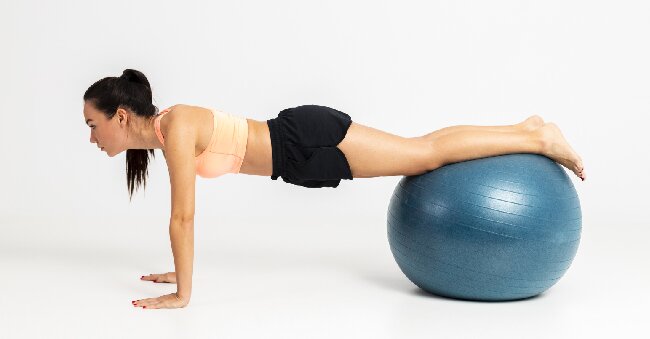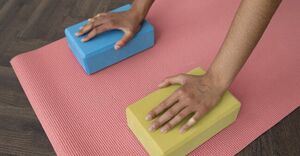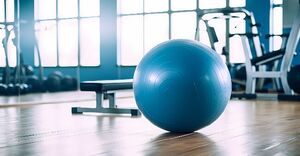
Maximize Your Core Strength with These Top Stability Ball Moves
Looking to enhance core strength and improve overall stability?
We delve into the significance of core strength, the advantages of a strong core, and how stability balls can assist you in achieving your fitness objectives.
From focusing on particular muscles to the best stability ball exercises for core strength, we have all the information you need.
Keep an eye out for recommendations on using stability balls securely and efficiently, and discover how frequently to incorporate these exercises into your workout regimen. Let’s optimize core strength with these top stability ball exercises!
What Is Core Strength?
Core strength is the ability of the muscles in the torso to support and stabilize the spine and pelvis, creating a stable base for all movements. A strong core is crucial for overall fitness and well-being, not just for obtaining visible abdominal muscles.
The core muscles play a vital role in nearly every physical activity, ranging from simple tasks like bending down to tie your shoes to engaging in intense workouts. Improving core stability can help reduce the risk of injury and enhance posture.
Functional movements such as bending, twisting, and lifting become more effective with well-developed core muscles. Including core-strengthening exercises like planks, Russian twists, and leg raises in your routine can lead to improved performance in sports, increased balance, and better alignment.
Why Is Core Strength Important?
Core strength is essential for maintaining balance, stability, and proper posture in daily activities as well as athletic performance. A strong core plays a vital role in overall health and wellness by decreasing the risk of injury and enhancing movement efficiency.
A stable core improves the body’s capacity to perform functional movements like bending, twisting, and lifting with increased control and comfort. Having a strong core also provides support for the spine and internal organs, promoting better alignment and reducing the chances of developing back pain or other musculoskeletal problems.
Enhanced posture resulting from core strength not only has physical benefits but also contributes to a confident and self-assured demeanor in various situations.
What Are the Benefits of Having a Strong Core?
Developing core strength through targeted exercises has numerous benefits, such as improved stability, better posture, decreased back pain, and increased muscular endurance. A strong core can also improve flexibility and make various movements easier and more efficient.
A well-developed core is essential for overall fitness as it supports daily activities like lifting, bending, and twisting. By incorporating core-strengthening exercises such as planks, Russian twists, and leg raises into your routine, you can improve your body’s ability to maintain proper alignment and balance during static and dynamic movements. This not only lowers the risk of injury but also enhances athletic performance and functional mobility in everyday life.
What Are Stability Balls?
Stability balls, also referred to as Swiss balls or exercise balls, are versatile fitness tools utilized for a wide range of exercises targeting various muscle groups, particularly the core muscles. These inflatable balls are frequently integrated into workout routines to improve balance, stability, and strength.
They present an unstable surface, compelling the body to activate more muscles to sustain balance during exercises. This activation results in enhanced core strength and stability over time. Stability balls are commonly used in functional fitness workouts to simulate real-life movements and enhance overall coordination.
Their versatility makes them suitable for individuals of all fitness levels, providing adjustments to modify exercise intensity. Incorporating stability balls into a fitness routine can facilitate improvements in flexibility, posture, and muscle endurance, making them a valuable asset to any fitness regimen.
How Do Stability Balls Improve Core Strength?
Stability balls play a crucial role in enhancing core strength by activating stabilizing muscles that may not engage during typical exercises. These balls challenge balance and stability, compelling core muscles to work more and build greater strength across a wide range of motion.
This unique training approach results in enhanced muscle endurance, improved posture, and increased overall stability. By adding stability balls to a strength training regimen, individuals can focus on and strengthen deep core muscles that are often overlooked. The unstable nature of the ball necessitates continual adjustments, activating multiple muscle groups simultaneously for a more comprehensive workout. Regular utilization of stability balls can also aid in injury prevention by enhancing body awareness, coordination, and balance.
What Muscles Are Targeted by Stability Ball Exercises?
Stability ball exercises are designed to primarily target the abdominal muscles, such as the rectus abdominis, obliques, and transverse abdominis. These exercises also involve other muscle groups, delivering a comprehensive full-body workout that improves core stability and strength.
Integrating stability ball exercises into a fitness routine not only strengthens core muscles but also enhances overall balance, coordination, and posture. By challenging stabilizing muscles like the erector spinae and hip flexors, these exercises encourage improved alignment and efficient movement patterns.
The dynamic nature of stability ball exercises requires the body to continuously adjust and engage multiple muscle groups simultaneously, leading to a more functional and robust physique. This holistic fitness approach not only targets specific muscles but also enhances proprioception and body awareness, promoting better movement control.
Top Stability Ball Moves for Core Strength
Incorporating stability ball moves into a fitness routine can enhance core strength and stability. These exercises target various muscle groups, providing a comprehensive workout that effectively strengthens and stabilizes core muscles.
Utilizing a stability ball activates core muscles more than traditional floor exercises because you must constantly stabilize your body during movements. For example, stability ball crunches not only target the rectus abdominis but also involve the obliques and lower back muscles.
Performing planks on the ball requires core and leg stabilization, increasing the workout challenge. By including these varied exercises, a dynamic core workout routine can be created that improves overall stability and strength.
1. Plank on the Ball
The plank on the stability ball is an exercise that targets the abdominal muscles, especially the deep core stabilizers. Balancing on the ball in a plank position engages the abs, obliques, and lower back, promoting core stability and strength.
The instability of the ball requires the core muscles to work harder to maintain balance, making this exercise effective for building core strength. To perform the plank on the stability ball correctly, start by placing your forearms on the ball with elbows shoulder-width apart. Keep your body in a straight line from head to heels, engage your core by drawing your navel toward your spine. Hold this position for at least 30 seconds, focusing on maintaining proper form and breathing steadily to maximize the benefits for your abs and core stability.
2. Russian Twist
The stability ball Russian twist is a core exercise that involves twisting the torso from side to side while balancing on the ball. This movement targets the obliques, transverse abdominis, and hip flexors, promoting core strength and balance.
The instability of the ball increases the demand on the core muscles to stabilize the body during the twisting motion, intensifying the workout. Plus working the midsection muscles, this exercise helps enhance overall balance and coordination. Incorporating the stability ball adds a new challenge to standard core exercises, diversifying the routine and stimulating the muscles in different ways.
3. Stability Ball Crunches
Stability ball crunches are a beneficial core workout that enhances core stability and strength. Performing crunches on a stability ball engages the abdominal muscles more intensely than traditional floor crunches, leading to improved core stability and balance.
The unstable surface of the stability ball requires your core muscles to work harder to maintain balance during the exercise, activating deep stabilizing muscles. This additional challenge not only enhances core strength but also aids in improving posture and overall stability in various activities.
Including stability ball crunches in your regular routine can result in a more functional and resilient core, making daily movements and exercises easier and more efficient.
4. Side Plank with Leg Lift
The side plank with leg lift on a stability ball is an advanced core exercise that targets the obliques, glutes, and hip stabilizers. This exercise involves lifting the leg while maintaining a side plank position on the stability ball, which helps strengthen the core muscles and enhance overall stability.
Participating in this challenging exercise not only aids in improving core strength but also boosts balance and coordination. The instability of the stability ball introduces an additional level of difficulty, requiring the core muscles to work harder to retain control and alignment. Adding this exercise to your core strength routines can contribute to better posture and a reduced risk of injuries, as a strong core is crucial for overall body stability and functionality.
5. Bridge with Leg Extension
The bridge with leg extension exercise on a stability ball targets the lower back, glutes, hamstrings, and core muscles. By lifting the hips into a bridge position and extending one leg at a time, it strengthens the core, enhances abdominal strength, and improves core stability.
This exercise is particularly effective for engaging the deep core muscles, including the transverse abdominis and pelvic floor muscles, which play a crucial role in stabilizing the spine. As each leg is lifted while maintaining the bridge position, the core has to work harder to keep the body stable. This not only helps in toning and sculpting the abdominal muscles but also aids in improving overall core strength and stability. Regular practice of this exercise can also contribute to better posture and reduced risk of lower back pain.
Tips for Using Stability Balls Safely and Effectively
When incorporating stability balls into workouts, it is important to select the appropriate size ball that matches the individual’s height and exercise requirements. Employing correct form and commencing at a gradual pace are essential for safety and effectiveness. It is advisable to advance progressively in difficulty and explore the addition of other exercises to establish a comprehensive fitness regimen.
This approach ensures that core muscles are engaged efficiently while maintaining balance. It is recommended to keep feet flat on the ground and the back straight during exercises. Starting with fundamental movements like stability ball crunches or planks before moving on to more challenging exercises is suggested. The stability ball can also be utilized for upper body workouts by integrating push-ups or shoulder presses. By incorporating a variety of movements, various muscle groups can be targeted to improve overall strength and stability.
1. Choose the Right Size Ball
Choosing the correct size stability ball is important for maintaining balance during exercises and ensuring effective engagement of core muscles. Selecting a ball that suits your height and exercise requirements will enhance the benefits of stability ball workouts.
When picking a stability ball, it’s important to take into account your individual needs and fitness goals. A ball that is too small can restrict your range of motion and diminish exercise effectiveness, while a ball that is too large may compromise your stability.
The right-sized ball will enable proper alignment of your body, allowing you to engage your core muscles efficiently. By striking the right balance between size and functionality, you can improve your stability, strengthen your core, and enhance overall workout performance.
2. Use Proper Form
It is important to maintain proper form while exercising with a stability ball to enhance flexibility and strengthen core muscles effectively. Ensuring correct posture and alignment is crucial not only for injury prevention but also for targeting the specific muscle groups intended for optimal results.
When using stability balls, focusing on body alignment and keeping a neutral spine is essential for activating core muscles and enhancing flexibility. Emphasizing proper form can improve balance and stability during exercises such as planks, bridges, or twists. The instability of the ball necessitates increased core engagement to stabilize movements, resulting in greater muscle activation and a comprehensive workout. This can contribute to building a strong core, preventing muscle imbalances, and reducing the risk of strain or injury.
3. Start Slowly and Progress Gradually
Starting stability ball exercises at a comfortable pace and gradually increasing the intensity is important for developing functional fitness and improving core stability. Progressing slowly allows the body to adapt and build strength effectively for long-term fitness improvements.
By gradually incorporating stability ball workouts, it allows the muscles and stability to adjust and improve without the risk of injury. Beginning with basic exercises like stability ball crunches, planks, and bridges helps engage the core muscles.
As confidence and comfort levels increase, more challenging variations and movements can be added to continue progressing. Consistency is key in functional fitness training; it’s better to do a small amount each day rather than pushing too hard and risking fatigue.
Listening to the body and recognizing its limits will ensure steady gains in strength and stability over time.
4. Incorporate Other Exercises into Your Routine
Incorporating a combination of exercises with stability ball workouts can boost core strength, enhance balance, and offer a comprehensive fitness regimen. By mixing stability ball exercises with bodyweight movements like squats, lunges, and push-ups, multiple muscle groups are engaged simultaneously, leading to a more effective workout. Including strength training exercises such as deadlifts or overhead presses can intensify the challenge to core stability and improve overall muscle growth. This varied approach not only prevents workout plateaus but also aids in developing functional strength that can translate to enhanced performance in daily activities.
How Often Should You Do Stability Ball Exercises?
The frequency of stability ball exercises varies depending on an individual’s fitness goals, current level of physical fitness, and exercise routine. Incorporating stability ball workouts 2-3 times per week can enhance muscular endurance, promote physical fitness, and contribute to overall strength building.
Consistency is emphasized for seeing progress in workout programs. By committing to regular stability ball sessions, individuals can effectively target various muscle groups, improve balance, and increase core strength. Varying exercises and intensity levels can help prevent plateaus and maintain challenging workouts. It is important to listen to the body, gradually progress in difficulty to avoid injury, and maximize results. Each person’s fitness journey is unique, so it is recommended to tailor stability ball routines to suit specific goals and fitness levels.




No Comments